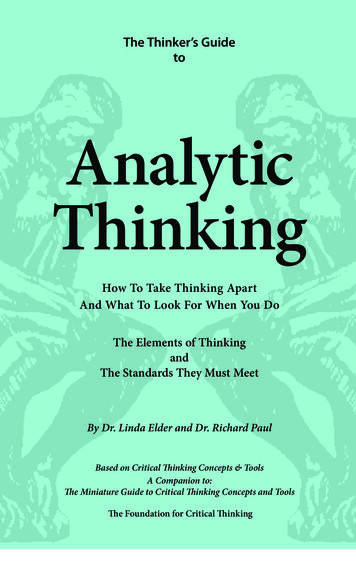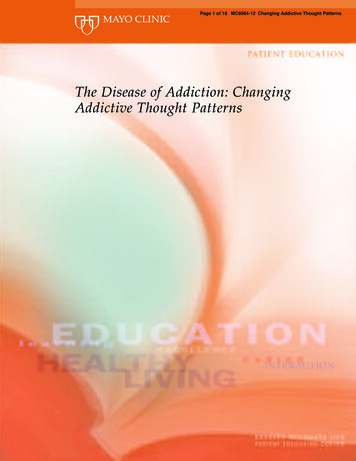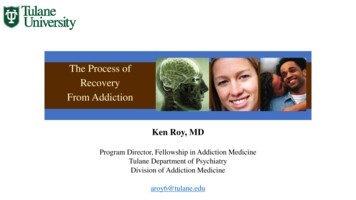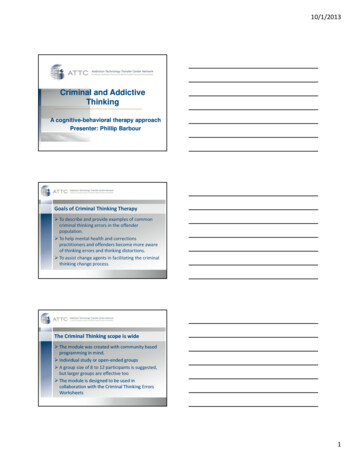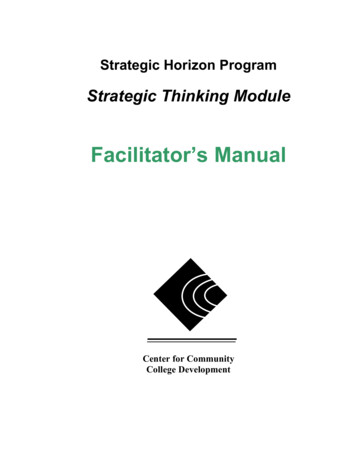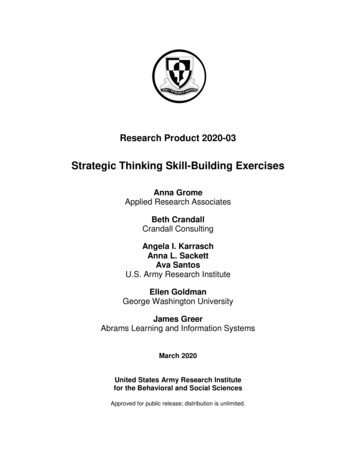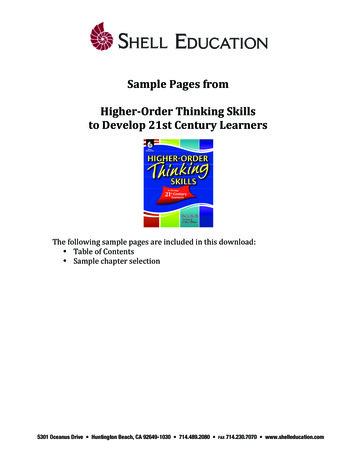
Transcription
SamplePagesfromHigher- her-Order Thinking Skills to Develop 21st CenturyLearners provides educators with the support theyneed to build every students’ mastery of high-level thinkingskills. Educators will learn why the qualities of a 21stcentury thinker are essential for today’s students and howto incorporate a research- and strategy-based approach topromote higher-order thinking in any academic setting withall learners—struggling and English language learners aswell. This resource provides examples from current classroomteachers at multiple grade levels and shares strategies, suchas the William’s Model of questioning, that will not only helpstudents become independent thinkers and problem solvers,but also will support them in becoming lifelong learners.Higher-Order Thinking Skills—John Barell, Ed.D.Author of Why Are SchoolBuses Always Yellowand Developing MoreCurious MindsConklin“Wendy Conklin’s book isa comprehensive summaryof how we challengestudents to inquireand think productively.Congratulations to herfor emphasizing the needfor all students to posetheir own questions as amost significant elementof education in the 21stcentury. Students assumingmore control of andresponsibility for theirown learning is one way ofbecoming more responsiblecitizens in our globalizedsociety and interdependenteconomy.”Wendy Conklin, M.A., is an educationalconsultant and award-winning author. Aformer teacher, Wendy now trains otherteachers in staff development workshops andalso presents at national conferences. Herpassion is to promote critical thinking andcreativity to develop thinkers for the isdownload: TableofContents SamplechapterselectionSEP 50822 24.997.33 x 9.25 50lb 128pp–143pp5301 Oceanus Drive Huntington Beach, CA 92649-1030 714.489.2080 FAX714.230.7070 www.shelleducation.com
Higher-Order Thinking Skills to Develop 21st CenturyLearners provides educators with the support theyneed to build every students’ mastery of high-level thinkingskills. Educators will learn why the qualities of a 21stcentury thinker are essential for today’s students and howto incorporate a research- and strategy-based approach topromote higher-order thinking in any academic setting withall learners—struggling and English language learners aswell. This resource provides examples from current classroomteachers at multiple grade levels and shares strategies, suchas the William’s Model of questioning, that will not only helpstudents become independent thinkers and problem solvers,but also will support them in becoming lifelong learners.Wendy Conklin, M.A., is an educationalconsultant and award-winning author. Aformer teacher, Wendy now trains otherteachers in staff development workshops andalso presents at national conferences. Herpassion is to promote critical thinking andcreativity to develop thinkers for the 21stcentury.SEP 50822 24.997.33 x 9.25 50lb 128pp–143ppHigher-Order Thinking Skills—John Barell, Ed.D.Author of Why Are SchoolBuses Always Yellowand Developing MoreCurious MindsConklin“Wendy Conklin’s book isa comprehensive summaryof how we challengestudents to inquireand think productively.Congratulations to herfor emphasizing the needfor all students to posetheir own questions as amost significant elementof education in the 21stcentury. Students assumingmore control of andresponsibility for theirown learning is one way ofbecoming more responsiblecitizens in our globalizedsociety and interdependenteconomy.”
AuthorWendy Conklin, M.A.ForewordR. Bruce Williams
Table of ContentsForeword .7Acknowledgements .11Chapter 1: A Brief Introduction toHigher-Order Thinking Skills.13Characteristics of Higher-Order Thinking Skills.14Is Bloom’s Taxonomy Related to Higher-Order Thinking?.17Rigor Is Involved .18The Necessity of Higher-Order Thinking Skills.19Conclusion .21Let’s Think and Discuss .22Chapter 2: The 21st Century Thinker .23Essential Qualities of a 21st Century Thinker .2321st Century Thinkers Ask Questions .2521st Century Thinkers Think Strategically .2721st Century Thinkers Use Logical Reasoning .2821st Century Thinkers Exercise Metacognition .3021st Century Thinkers Make Inferences .3321st Century Thinkers Can Problem-Solve .3321st Century Thinkers Innovate and Create .3521st Century Thinkers Possess Emotional Intelligence .3521st Century Thinkers Communicate Effectively .36Conclusion .38Let’s Think and Discuss .383
Chapter 3: Cognitive Development andHigher-Order Thinking .39When Can Students Think Critically? .39The Impact of the Classroom on Brain Growth.40Using Higher-Order Thinking to Challenge Students .42Reasons to Begin Early .44How to Develop Higher-Order Thinking Early.44How to Maintain Higher-Order Thinkingin the Classroom .47Conclusion .49Let’s Think and Discuss .50Chapter 4: Platforms for Higher-Order Thinking .51Historical Thinking .52Visual Literacy.56Mathematical Reasoning .58Scientific Inquiry.62Conclusion .64Let’s Think and Discuss .65Chapter 5: Strategies for Higher-Order Thinking Skills .67Questioning Strategies .68Revised Bloom’s Taxonomy .68The Williams Model .73The Socratic Method.76Depth of Knowledge .78Problem-Solving Strategies .81Problem-Based Learning.81Creative Problem-Solving Model .87The Wallas Model .914
Decision-Making Strategies .94Strategic Thinking Activities.95Simulations .98Games .101Idea-Generating Strategies and Activities .103Brainstorming and Brainwriting .103SCAMPER.107Thinking Organizers .111Creative Strategies .113Creative Dramatics .113Creative Writing .116Project-Based Learning .118Open-Ended Tasks .121Conclusion .124Let’s Think and Discuss .124Chapter 6: Management Techniques to FacilitateHigher-Order Thinking .125Curriculum Compacting .126Anchor Activities .127Cooperative Learning .130Grouping .132Flexible Grouping .133Homogeneous Grouping .134Heterogeneous Grouping .134Flexogeneous Grouping .135Conclusion .136Let’s Think and Discuss .1365
Chapter 7: Differentiating Higher-Order Thinking.137Differentiating by Process .138Differentiating by Content .140Differentiating by Product.144Menu of Options .144Leveled Learning Centers .145Choices Boards .146Conclusion .147Let’s Think and Discuss .147Chapter 8: Higher-Order Thinking forEnglish Language Learners .149Saved by Common Sense .149English Language Learners in Our Classrooms .151Ways to Integrate Thinking Skills andLanguage Development .153Conclusion .159Let’s Think and Discuss .160Chapter 9: Assessing Higher-Order Thinking Skills .161Identifying the Desired Results .162Determining the Assessment Evidence .163Planning Learning Experiences .168Conclusion .169Let’s Think and Discuss .169Chapter 10: Putting It All Together .171Selecting a Strategy .172Creating a Plan.172Assessment .174Conclusion .175Let’s Think and Discuss .175References Cited .1766
ChapterStrategies forHigher-Order Thinking SkillsOh, boy. I’ve gotbooks and books onstrategies!Not anotherstrategy to learn!How do you know ifa strategy promoteshigher-order thinking?What makesyour strategiesso muchbetter than mystrategies?There are many strategies that promote higher-order thinkingskills. This chapter contains just a sampling of ways to infusecurriculum with specific strategies that promote higher-order thinkingskills. These strategies include questioning strategies, problem-solvingstrategies, decision-making strategies, idea-generating strategiesand activities, thinking organizers, creative strategies, project-basedlearning, and open-ended tasks.675
The Socratic MethodInquiry is at the heart of the Socratic seminar, Socratic dialogue, orSocratic method, as it is most commonly called. This strategy is namedafter the philosopher Socrates, who used a broad form of questioningwith his students. Each question that is answered predetermines thenext question. Socrates used it to show his students the error of theirthinking. Since the time Socrates used inquiry to promote thinking,the Socratic method has changed somewhat through the years. Today,this method is used primarily as a process of inductive questioning,through small steps, with knowledge as the goal. In a classroom, ateacher can use a set of questions to provoke students to think aboutsomething. The questions push students to examine what they knowwith the result of them analyzing a topic in depth.By using the Socratic method, learners can come to value andrecognize good questions while also improving upon a thoughtfulmethod of thinking. Students become more curious about the topic.They experience the joy of discovery. Students also get immediatefeedback, and teachers can monitor student understanding by makingadjustments, clarifying, and correcting misgivings immediately insteadof waiting until the end of the unit test to find out that studentsdid not understand the material. For the teacher, teaching is moreinteresting because he or she can quickly glean the thought processesof the students. Classes will respond differently, so even content-areateachers who teach the same class multiple times daily will not growbored with student responses. This method also allows teachers to seestudent potential, as some students might pose exceptional questionsthat might not happen during a regular class.Some might mistakenly think that the Socratic method requires verylittle preparation. On the contrary, to implement the Socratic methodin class, there is strategic teacher preparation involved. First, teachersshould make a list of good questions to ask and mentally go throughthe conversation beforehand. The first questions are designed to showwhat students understand about the topic so the teacher knows whereto begin. The questions need to follow a logical sequence of steps that76
takes learners from one point of knowledge to another. The questionsshould follow a logical path that supports what the teacher wantsstudents to learn. These questions should be specific enough to leadstudents to the desired understanding while also engaging students sothat curiosity is piqued.If students answer incorrectly, a teacher must decide whether studentsneed to know why their answer is wrong or not. Not all questionswill be the best or even appropriate, so teachers need to be open to theidea of fine-tuning how they question their students.Dr. Richard Paul is the director of research and professionaldevelopment at the Center for Critical Thinking and chair of theNational Council for Excellence in Critical Thinking. He hasclassified Socratic questions into six different categories which arelisted in the figure on the following page. Within each category, thereare questions that support the area of focus. It is the basic practicethat, while these do not follow a hierarchy of questions, they can leadone to another (Paul and Elder 2002).77
Socratic QuestionsQuestions that clarify What is an example of ?Can you explain ?How would you say this in your own words?What is the right way to define this?Questions that probeassumptions Why do you think this way about ?What are your assumptions?What do you believe to be true?What else could we believe about this?Questions that look forreasons and evidence What makes you believe this?How do we know this is true?What else do we need to know?What would make you change your mindabout ?Questions aboutperspectives andviewpoints Whose viewpoint is this?What bias does this have?What is another view about ?How many more perspectives could there beabout ?Questions that look atconsequences How does this affect ?Why is this important?What effect can this have on ?If this is true, then what else might be true?Questions about thequestion What does this question mean?Is this a good question?Why was this question asked?What does this have to do with our lives?(Adapted from Paul and Elder 2002)Depth of KnowledgeDepth of Knowledge (DOK) is a scale of cognitive demand thatuses questions, tasks, and products ranked at four levels. The scaleis adapted from the work of Norman Webb at the University ofWisconsin.The levels of thinking are differentiated by the complexity ofmental processing required. Some equate the idea of difficulty with78
complexity. However, the difficulty of a question is usually assessedby how many students can answer the question, do the task, or createthe product. Can students find the area of a room? If many studentscan do this, then it is an easy task. If not many students can do this,then it can be ranked as a difficult task. Depth of Knowledge relies oncomplexity, not difficulty. It focuses on the complexity of the mentalprocess that it takes for students to answer questions, perform tasks,or create products.Level 3 is strategic thinking and requires a deep understanding ofthe story, the character, and humankind. It is open-ended, butstudents must take what they know about the character and puttogether probable events and experiences that impacted that character.Level 2 is more complex than Level 1 because students are comparingthe character to themselves, so their answers will vary. Level 1 onlyasks students to describe the character based on what they have read,so it is a simple recall question.The four levels of thinking are as follows: Level 1 is described as the recall level, where facts,information, or procedures are recalled. It requires the lowestlevel of thinking. Level 2 is described as the skill or concept level. Typically,students classify, organize, estimate, collect, display, observe,and compare data. They use the information they know. Thislevel requires deeper thinking than does Level 1. Level 3 is characterized by strategic thinking. Reasoning,planning, and making conjectures are typical at this level.The open-ended tasks are not necessarily what makes thislevel a higher-order thinking activity. Higher-order thinkingcomes into play when students have to defend the reason forselecting their answers. Students draw conclusions, supporttheir conclusions with evidence, or determine which conceptto apply to solve a problem.79
Level 4 is described as extended thinking and is the highestlevel of thinking. It is characterized by complex reasoningby which students make interdisciplinary connections. Moreoften than not, activities at this level take a prolonged periodof time. However, be aware that just because a project takesan extended period of time to complete it does not mean thatit is a Level 4 task. Level 4 requires an investigation of somesort with a project showing the results of the complex thinkinginvolved. The following Level 4 activity can be added to theexample on characteristics of a character.Look at five of your favorite stories, television shows, or movies andchoose a character from each one. Combine characteristics fromthose five characters to create one character that could be friendswith the main character in the story you are reading. First, detailwhat characteristics you would use from each character. Then, drawa picture of this new character and make notes on the page that showwhy this character would be a likely friend of the main character.What does he or she think? How does he or she act? What would heor she say? What is his or her personality like? Be sure to show thischaracter in detail and be ready to explain why this new character isperfect as a friend to the main character as well as how the story wouldchange with this newly added character.The key to the different levels of thinking is not necessarily in theverbs that are used; rather, it is in the depth of thinking that isdemanded. What comes after the verbs classifies the level of thinking.For example, there are some verbs that do identify with a lower depthof thinking such as recall and identify. However, the verbs describeand explain could be used with different levels depending on whatneeds to be described and explained. The verbs must be consideredin context. Consider the following example:Level 1—Describe the main character in the story.Level 2—Describe how you are both similar to and different from thecharacter in the story.80
Level 3—Describe the possible events that could have led to how thecharacter came to be this way and give reasons for your answer.Similarly to Bloom’s Taxonomy, Depth of Knowledge levels can becumulative. For example, Level 3 and Level 4 questions and activitiesoften will contain Levels 1 and 2. When planning lessons, try to usemore of the Levels 3 and 4, which promote higher-order thinking.Decide what students will research and what final project or productthey will produce to show what they have learned in a creative way.These activities should incorporate interdisciplinary activities whenpossible.Problem-Solving StrategiesProblem-Based LearningProblem-based learning is a problem-solving strategy that engagesstudents in solving a real-life or lifelike problem. These problemscan range from students breaking the dress code to establishing safeevacuation routes for hurricane warnings. This strategy is known forits group work along with independent investigations and inquiry.According to James Rhem (1998), problem-based learning “orientsstudents toward meaning-making over fact-collecting. They learn viacontextualized problem sets and situations” (1998, 1). Problem-basedlearning as we know it today was first used in the 1950s at CaseWestern Reserve University. It is described as “a curriculumdevelopment and instructional system that simultaneously developsboth problem-solving strategies and disciplinary knowledge basesand skills by placing students in the active role of problem solversconfronted with an ill-structured problem that mirrors real-worldproblems” (Finkle and Torp 1995, 1). Even before the 1950s, JohnDewey had the right idea about learning. In the 1930s, Dewey (1916)said that school should be lifelike instead of merely preparing studentsfor life. It has been said that using a problem-based approach tolearning may be one of the best ways to understand concepts within81
a subject area (Barell 2003). Teachers who use a problem-basedapproach in the classroom not only help students grasp particularconcepts but they also pave the way for future learning. Once studentslearn how to solve one problem, they can transfer that knowledge tosolve more problems (Bransford, Franks, and Sherwood 1986). Anadded benefit is that students remember what they learn because theyhave opportunities to apply the concepts in more complex ways.Problem-based learning gives students the opportunity to collaboratewith their classmates as they study the issues surrounding a certainproblem. They use information they find through research tosynthesize viable solutions. The amount of direct instruction in aproblem-based classroom is very limited, so students have to take onthe responsibility for their own learning. The teacher’s role is muchlike a coach. He or she presents the problematic situation, becomesthe subject-matter expert, acts as a resource guide and consultant,and serves as a co-investigator who keeps the students on task. Theteacher asks questions like, Why? What do you mean? How do youknow that is true? He or she questions students’ logic and giveshints about erroneous reasoning and models critical thinking sothat students will begin to ask the same kinds of questions of oneanother. The student’s role is that of a participant who grapples withthe complexity of the situation while investigating and resolving theproblem from the inside out.Think about this scenario as a student in today’s classroom:Vandalism is on the rise in your school. Lockers have beenbroken into, students’ belongings have been stolen, furniturehas been scratched, and walls have been written on duringschool hours. The school has decided to implement safetymeasures. Hall passes will be strictly enforced, and no one willbe allowed to leave the cafeteria during lunch. These rulesseem extreme to you. You feel that innocent students are beingpunished for what only a few do. There has to be a better wayto stop the vandals. What can you do?82
Your teacher allows you to work in groups to generate possibleideas or solutions to this problem. You decide to write apetition, form volunteer patrols, and survey students. Youidentify available information related to this problem byreviewing school policies, viewing a sample petition, andlooking at parts of the school that have been vandalized. Youidentify issues that need to be investigated further—how toform patrols, what other schools are doing, and how to writea survey. Your group finds resources to consult, like policiesfrom other schools and sample surveys. Group members areassigned the tasks above and information is gathered. Finally,your group presents your solution to the school board. This isproblem-based learning.There are many reasons for using problem-based learning withstudents. First, we know that our minds are capable of thinkingthrough complex situations, which promotes higher-level thinkingskills. Research says that it is the complex challenges that develop ourintellect and ability to think productively (Caine and Caine 1997;Diamond and Hopson 1998). These types of problems do notprovide just one right answer. Students are forced into thinking bothcritically and creatively as they seek to find solutions to problems.Problem-based learning also increases motivation in students.Recently, some professors at the college level have begun to restructuretheir course work around problem-based learning. They do this bytaking the final exam and working backward to structure the coursearound a problem that teaches the key concepts they want theirstudents to learn. They freely admit that it is a lot of work to do thisbut that the results of both student and teacher engagement are wellworth it. In fact, they dare say that none of their colleagues have goneback to lecture after using problem-based learning (Rhem 1998).Students see that the outcome of their work can make a real differencein society. It shows that what they do in school can have an impact inthe real world, and this builds student confidence.83
This type of learning provides opportunities for students to work withothers in collaborative groups, which in turn prepares them for theirfuture workplaces where teamwork is both valued and required. Ina successful problem-based learning activity, students must listen toone another, synthesize information, and work together. For somestudents, this can be difficult. Some teachers feel more daunted bythis classroom structure than anything else. It does take patienceand strategic planning on the teacher’s part to train students to workeffectively together. Typically, no one has trouble working with otherswho respect their opinions, listen to their ideas, and try to compromisein one way or another. The problems arise when the exact opposite istrue. While it can be a bother to put out fires all day long, providingstudents with the encouragement, strategies, and experiences ofdealing with difficult people is invaluable. Problem-based learningprovides the perfect avenue to teach students how to work with others.While collaborating, great ideas can flow freely. Brainstorming withothers brings out creative ideas that might not have been evidentif students had been working alone. Problem-based learning iscontinual brainstorming of what the problem is and how it can besolved. As one student shares, it might spark an idea in anotherstudent. It teaches students to appreciate other viewpoints and ideas.Problem-based learning provides students the chance to developstrong work ethics. So much work, energy, and thinking goes intosolving problems. Strategies are generated for identifying and definingthe problem, gathering information, analyzing data, and building andtesting the hypothesis. All of these steps are important life skills thattrain students to be hard workers.Finally, problem-based learning is active. A problem-solving contextis the best way to acquire information (Tyler 1949). As studentsstruggle to figure out a problem and apply what they are learning,they are more likely to remember the key concepts taught in thatlesson. The way that students are engaged in learning information issimilar to the way students will recall it and use it in the future.84
A typical problem-based learning lesson has several cycles. These stepscan be repeated as many times as necessary to come to a conclusion.The steps are the following:1. Locate a real-world problem. It is best if this problem canconnect to learning standards and goals.2. D
Higher-Order Thinking Skills T here are many strategies that promote higher-order thinking skills. This chapter contains just a sampling of ways to infuse curriculum with specific strategies that promote higher-order thinking skills. These s



